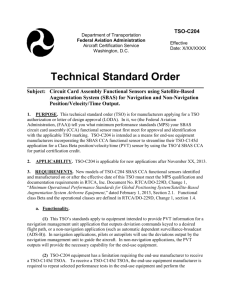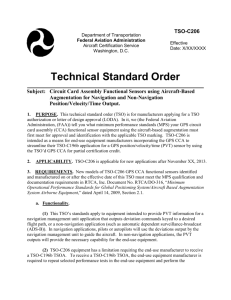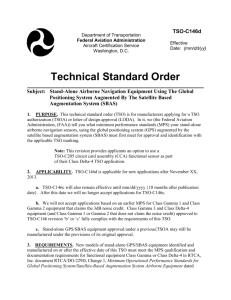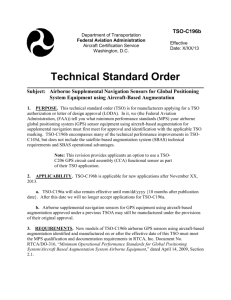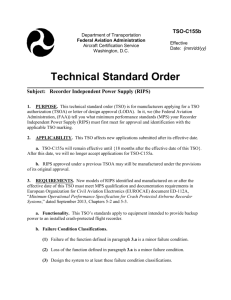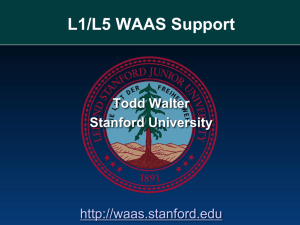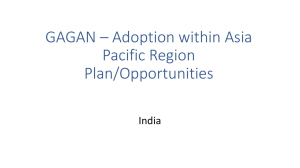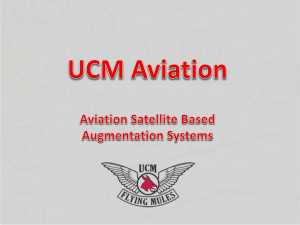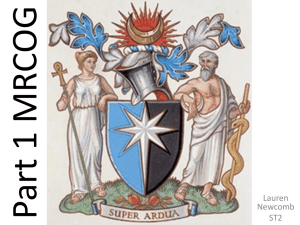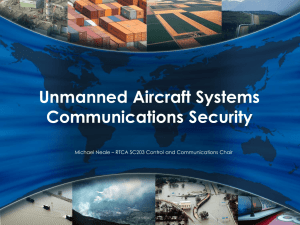C145d - General Aviation Manufacturers Association
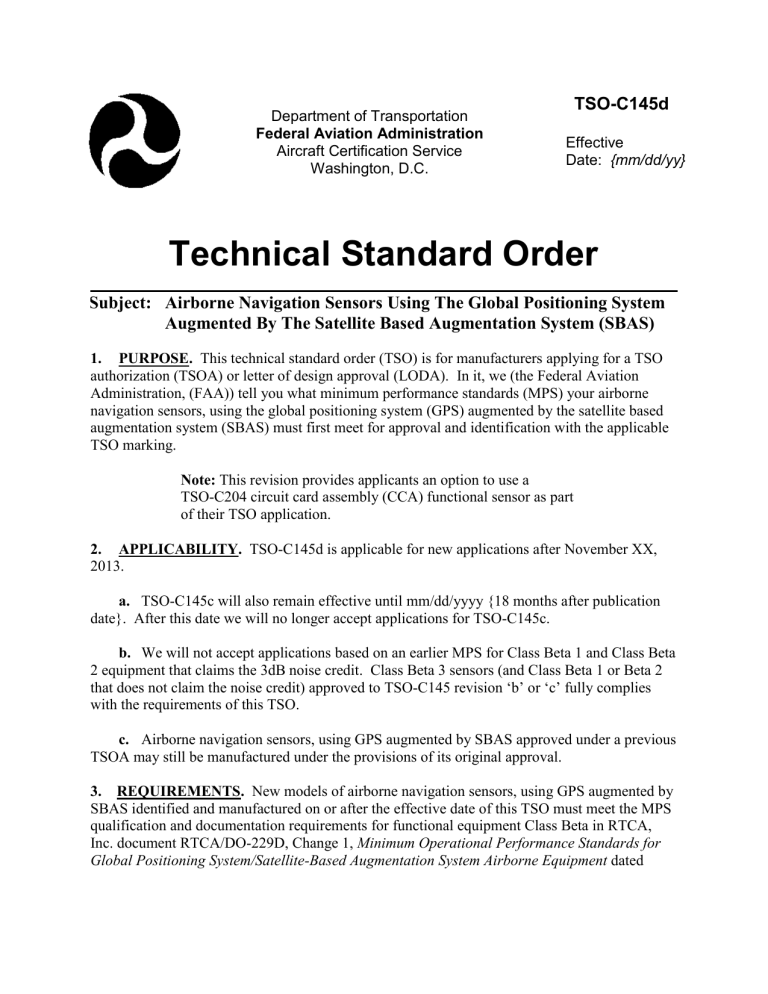
Department of Transportation
Federal Aviation Administration
Aircraft Certification Service
Washington, D.C.
TSO-C145d
Effective
Date: {mm/dd/yy}
Technical Standard Order
Subject: Airborne Navigation Sensors Using The Global Positioning System
Augmented By The Satellite Based Augmentation System (SBAS)
1. PURPOSE. This technical standard order (TSO) is for manufacturers applying for a TSO authorization (TSOA) or letter of design approval (LODA). In it, we (the Federal Aviation
Administration, (FAA)) tell you what minimum performance standards (MPS) your airborne navigation sensors, using the global positioning system (GPS) augmented by the satellite based augmentation system (SBAS) must first meet for approval and identification with the applicable
TSO marking.
Note: This revision provides applicants an option to use a
TSO-C204 circuit card assembly (CCA) functional sensor as part of their TSO application.
2. APPLICABILITY.
TSO-C145d is applicable for new applications after November XX,
2013. a.
TSO-C145c will also remain effective until mm/dd/yyyy {18 months after publication date}. After this date we will no longer accept applications for TSO-C145c. b.
We will not accept applications based on an earlier MPS for Class Beta 1 and Class Beta
2 equipment that claims the 3dB noise credit. Class Beta 3 sensors (and Class Beta 1 or Beta 2 that does not claim the noise credit) approved to TSO-C145 revision ‘b’ or ‘c’ fully complies with the requirements of this TSO. c.
Airborne navigation sensors, using GPS augmented by SBAS approved under a previous
TSOA may still be manufactured under the provisions of its original approval.
3. REQUIREMENTS. New models of airborne navigation sensors, using GPS augmented by
SBAS identified and manufactured on or after the effective date of this TSO must meet the MPS qualification and documentation requirements for functional equipment Class Beta in RTCA,
Inc. document RTCA/DO-229D, Change 1, Minimum Operational Performance Standards for
Global Positioning System/Satellite-Based Augmentation System Airborne Equipment dated
TSO-C145d mm/dd/13
February 1, 2013, Section 2.1. Class Beta equipment is defined in RTCA/DO-229D, Change 1,
Section 1.4.
TSO-C145d applicants have the option to use a TSO-C204 SBAS CCA functional sensor.
Applicants choosing to use a TSO-C204 SBAS CCA can take certification compliance credit by virtue of the TSO-C204 TSOA for:
Meeting the MPS section 2.1 requirements;
The hardware/software qualification;
The failure condition classification; and,
MPS section 2.5 performance testing (functional qualification) except for those tests specified in Appendix 1 of this TSO.
The TSO-C145d applicant using a TSO-C204 CCA functional sensor shall perform the testing described in Appendix 1 and satisfy the remaining paragraphs in this TSO not covered by the bullets above to receive a TSO-C145d TSOA.
Note: The end-use manufacturer that uses a TSO-C204 SBAS
CCA functional sensor as part of their TSO-C145d application assumes full responsibility for the design and function under their
TSO-C145d TSOA per 14 CFR § 21 Subpart O. a. Functionality. This TSO’s standards apply to equipment intended to provide position information for a navigation management unit application that outputs deviation commands keyed to a desired flight path, or a non-navigation application such as automatic dependent surveillance-broadcast (ADS-B) or terrain awareness and warning system (TAWS). In navigation applications, pilots or autopilots will use the deviations output by the navigation management unit to guide the aircraft. In non-navigation applications, the position outputs will provide the necessary input for the end-use equipment. But these TSO standards do not address integration issues with other avionics. b. Failure Condition Classifications.
(1) Failure of the function defined in paragraph 3.a
resulting in misleading information for en route, terminal, approach lateral navigation (LNAV), and approach LNAV/vertical navigation (VNAV) position data is a Major failure condition,
(2) Failure of the function defined in paragraph 3.a
resulting in misleading information for localizer performance without vertical guidance (LP), and approach localizer performance with vertical guidance (LPV) position data is a Hazardous failure condition, and
(3) Loss of the function defined in paragraph 3.a
for en route through LP/LPV position data is a Major failure condition.
(4) Design the system to at least these failure condition classifications consistent with the operational capability.
2 xx/xx/xx
TSO-C145d mm/dd/13 c. Functional Qualification.
(1) Demonstrate the required functional performance under the test conditions specified in RTCA/DO-229D, Change 1, Section 2.5, or
(2) When using a TSO-C204 SBAS CCA functional sensor, demonstrate the required performance under the test conditions in appendix 1 of this TSO. d. Environmental Qualification.
Demonstrate the required performance under the test conditions specified in RTCA/DO-229D, Change 1, Section 2.4 using standard environmental conditions and test procedures appropriate for airborne equipment. You may use a different standard environmental condition and test procedure than RTCA/DO-160G, Sections 4.0 through
8.0 and 10.0 through 25.0 provided the standard is appropriate for the airborne navigation sensors, using GPS augmented by SBAS.
Note 1: The use of RTCA/DO-160D (with Changes 1 and 2 only, incorporated) or earlier versions is generally not considered appropriate and will require substantiation via the deviation process as discussed in paragraph 3.g
of this TSO.
Note 2: Applicants using a TSO-C204 SBAS CCA must perform the environmental qualification with the SBAS CCA in the end-use equipment. e. Software Qualification. If the article includes software:
(1) Develop the software according to RTCA/DO-178C, Software Considerations in
Airborne Systems and Equipment Certification , dated December 13, 2011 to at least the software level consistent with the failure condition classification defined in paragraph 3.b of this TSO, or
Note 1 : The certification liaison process objectives will be considered satisfied after FAA review of the applicable life cycle data.
Note 2 : Applicants should refer to AC 20-115C for meeting
RTCA/DO-178C with legacy software or software development methods.
(2) Applicants using a TSO-C204 SBAS CCA functional sensor may use TSO-C204 as substantiation for the software qualification. f. Electronic Hardware Qualification.
If the article includes complex custom airborne electronic hardware: xx/xx/xx
3
TSO-C145d mm/dd/13
(1) Develop the component according to RTCA, Inc. Document RTCA/DO-254, Design
Assurance Guidance for Airborne Electronic Hardware to at least the design assurance level consistent with the failure condition classification defined in paragraph 3.b of this TSO. For custom airborne electronic hardware determined to be simple, RTCA/DO-254, paragraph 1.6 applies, or
Note : The certification liaison process objectives will be considered satisfied after FAA review of the applicable life cycle data.
(2) Applicants using a TSO-C204 SBAS CCA functional sensor may use TSO-C204 as substantiation for the hardware qualification.
g. Barometric-aided Fault Detection and Exclusion (FDE).
If the equipment uses barometric-aiding to enhance FDE availability, then the equipment must meet the requirements in RTCA/DO-229D, Change 1, appendix G. h. Deviations. We have provisions for using alternate or equivalent means of compliance to the criteria in the MPS of this TSO. If you invoke these provisions, you must show that your equipment maintains an equivalent level of safety. Apply for a deviation under the provision of 14 CFR § 21.618.
4. MARKING. a. Mark at least one major component permanently and legibly with all the information in
14 CFR § 45.15(b). The marking must include the serial number. b. Also, mark the following permanently and legibly, with at least the manufacturer’s name, subassembly part number, and the TSO number:
(1) Each component that is easily removable (without hand tools); and,
(2) Each subassembly of the article that you determined may be interchangeable. c.
If the article includes software and/or airborne electronic hardware, then the article part numbering scheme must identify the software and airborne electronic hardware configuration.
The part numbering scheme can use separate, unique part numbers for software, hardware, and airborne electronic hardware. d.
You may use electronic part marking to identify software or airborne electronic hardware components by embedding the identification within the hardware component itself
(using software) rather than marking it on the equipment nameplate. If electronic marking is used, it must be readily accessible without the use of special tools or equipment. e.
At least one major component must be permanently and legibly marked with the operational equipment class (for example, Class 2) as defined in RTCA/DO-229D, Change 1,
Section 1.4.2. xx/xx/xx
4
TSO-C145d mm/dd/13
5. APPLICATION DATA REQUIREMENTS. You must give the FAA aircraft certification office (ACO) manager responsible for your facility a statement of conformance, as specified in 14 CFR § 21.603(a)(1) and one copy each of the following technical data to support your design and production approval. LODA applicants must submit the same data (excluding paragraph 5.j
) through their civil aviation authority. a.
A Manual(s) containing the following:
(1) Operating instructions and equipment limitations sufficient to describe the equipment’s operational capability.
(2) Describe in detail any deviations.
(3) Installation procedures and limitations sufficient to ensure that the airborne navigation sensors, using GPS augmented by SBAS, when installed according to the installation or operational procedures, still meets this TSO’s requirements. Limitations must identify any unique aspects of the installation. The limitations must include a note with the following statement:
“This article meets the minimum performance and quality control standards required by a technical standard order (TSO).
Installation of this article requires separate approval.”
(4) For each unique configuration of software and airborne electronic hardware, reference the following:
(a) Software part number including revision and design assurance level;
(b) Airborne electronic hardware part number including revision and design assurance level; and,
(c) Functional description.
(5) A summary of the test conditions used for environmental qualifications for each component of the article. For example, a form as described in RTCA/DO-160G, Environmental
Conditions and Test Procedures for Airborne Equipment, Appendix A.
(6) Schematic drawings, wiring diagrams, and any other documentation necessary for installation of the airborne navigation sensors, using GPS augmented by SBAS.
(7) List of major components, such as an antenna, by part number, that make up the airborne navigation sensors, using GPS augmented by SBAS complying with the standards prescribed under this TSO. Include vendor part number cross-references, when applicable.
(a) If the equipment can satisfy the requirements of RTCA/DO-229D, Change 1 only when used with a particular antenna, make the use of that antenna (by part number) a requirement on the installation. Include this requirement in the IM as a limitation.
5 xx/xx/xx
TSO-C145d mm/dd/13
(b) If the equipment is installed with a standard antenna, include maximum tolerable currents and voltages into the antenna port. See TSO-C144a, Passive
Airborne Global Navigation Satellite System (GNSS) Antenna, applicable only to operational Class 1 equipment, or TSO-C190, Active Airborne Global Navigation
Satellite System (GNSS) Antenna, applicable to all equipment operational classes.
(8) List of replaceable components, by part number, that makes up the airborne navigation sensors, using GPS augmented by SBAS. Include vendor part number crossreferences, when applicable. b.
Instructions covering periodic maintenance, calibration, and repair, for the continued airworthiness of airborne navigation sensors, using GPS augmented by SBAS.
Include recommended inspection intervals and service life, as appropriate. c.
If not using a TSO-C204 SBAS functional sensor and the article includes software: a plan for software aspects of certification (PSAC), software configuration index, and software accomplishment summary. d.
If not using a TSO-C204 SBAS functional sensor and the article includes simple or complex custom airborne electronic hardware: a plan for hardware aspects of certification
(PHAC), hardware verification plan, top-level drawing, and hardware accomplishment summary
(or similar document, as applicable). e.
Nameplate drawing with the information required by paragraph 4 of this TSO. f.
Adequate specifics on the interface between the GPS/SBAS sensor and other systems to ensure proper functioning of the integrated system. If the equipment depends on any inputs (like baro-aided FDE) to satisfy the requirements of RTCA/DO-229D, Change 1, make those inputs a requirement in the installation. Include this requirement in the IM as a limitation. g.
If the software qualification limits eligibility of the equipment to certain aircraft types, identify the qualification level, and that the equipment is not eligible for all aircraft types. For example, AC 23-1309-1(), Equipment, Systems, and Installations in Part 23 Airplanes , states that RTCA/DO-178C Level C software may be associated with a hazardous failure condition for certain aircraft types. Identify other limitations applicable to the failure condition classification--
-for example, that two installed units are necessary. h.
If the equipment has not been demonstrated as compatible with satellite communications
(SatCom) state in the limitations that the equipment should not be installed in SatCom equipped aircraft. i.
Identify functionality or performance contained in the article not evaluated under paragraph 3 of this TSO (that is, non-TSO functions). Non-TSO functions are accepted in parallel with the TSO authorization. For those non-TSO functions to be accepted, you must declare these functions and include the following information with your TSO application:
(1) Description of the non-TSO function(s), such as performance specifications, failure condition classifications, software, hardware, and environmental qualification levels. Include a
6 xx/xx/xx
TSO-C145d mm/dd/13 statement confirming that the non-TSO function(s) don’t interfere with the article’s compliance with the requirements of paragraph 3 .
(2) Installation procedures and limitations sufficient to ensure that the non-TSO function(s) meets the declared functions and performance specification(s) described in paragraph
5.i.(1) .
(3) Instructions for continued performance applicable to the non-TSO function(s) described in paragraph 5.i.(1).
(4) Interface requirements and applicable installation test procedures to ensure compliance with the performance data defined in paragraph 5.i.(1).
(5) Test plans, analysis and results, as appropriate, to verify that performance of the hosting TSO article is not affected by the non-TSO function(s).
(6) Test plans, analysis and results, as appropriate, to verify the function and performance of the non-TSO function(s) as described in paragraph 5.i.(1).
j.
The quality system description required by 14 CFR § 21.608, including functional test specifications. The quality system should ensure that you will detect any change to the approved design that could adversely affect compliance with the TSO MPS, and reject the article accordingly. (Not required for LODA applicants.) k.
Material and process specifications list. l.
List of all drawings and processes (including revision level) that define the article’s design. m.
Manufacturer’s TSO qualification report showing results of testing accomplished according to paragraph 3.c of this TSO.
6. MANUFACTURER DATA REQUIREMENTS. Besides the data given directly to the responsible ACO, have the following technical data available for review by the responsible
ACO: a. Functional qualification specifications for qualifying each production article to ensure compliance with this TSO. b. Equipment calibration procedures. c. Schematic drawings. d. Wiring diagrams. e. Material and process specifications. xx/xx/xx
7
TSO-C145d mm/dd/13 f. The results of the environmental qualification tests conducted according to paragraph
3.d
of this TSO.
g. If not using TSO-C204 and the article includes software, the appropriate documentation defined in RTCA/DO-178C including all data supporting the applicable objectives in Annex A ,
Process Objectives and Outputs by Software Level . h.
If not using TSO-C204 and the article includes complex custom airborne electronic hardware, the appropriate hardware life cycle data in combination with design assurance level, as defined in RTCA/DO-254, Appendix A, Table A-l.
For simple custom airborne electronic hardware, the following data: test cases or procedures, test results, test coverage analysis, tool assessment and qualification data, and configuration management records, including problem reports.
i.
If not using TSO-C204, all the data necessary to evaluate the geo stationary (GEO) satellite bias as defined in RTCA/DO-229D, Change 1, Section 2.1.4.1.5. j . If the article contains non-TSO function(s), you must also make available items 6.a
through 6.h
as they pertain to the non-TSO function(s).
7. FURNISHED DATA REQUIREMENTS. a. If furnishing one or more articles manufactured under this TSO to one entity (such as an operator or repair station), provide one copy or on-line access to the data in paragraphs 5.a, 5.b, and 5.f through 5.h of this TSO. Add any other data needed for the proper installation, certification, use, or for continued compliance with the TSO, of the airborne navigation sensors, using GPS augmented by SBAS. b. If the article contains declared non-TSO function(s), include one copy of the data in paragraphs 5.i.(1) through 5.i.(4).
8. HOW TO GET REFERENCED DOCUMENTS. a. Order RTCA documents from RTCA Inc., 1150 18th Street NW, Suite 910,
Washington, D.C. 20036. Telephone (202) 833-9339, fax (202) 833-9434. You can also order copies online at www.rtca.org. b. Order copies of 14 CFR parts 21 and 45 from the Superintendent of Documents,
Government Printing Office, P.O. Box 979050, St. Louis, MO 63197. Telephone (202) 512-
1800, fax (202) 512-2250. You can also order copies online at www.access.gpo.gov. Select
“Access,” then “Online Bookstore.” Select “Aviation,” then “Code of Federal Regulations.” xx/xx/xx
8
TSO-C145d mm/dd/13 c.
You can find a current list of technical standard orders and advisory circulars on the
FAA Internet website Regulatory and Guidance Library at http://rgl.faa.gov/ . You will also find the TSO Index of Articles at the same site.
David W. Hempe
Manager, Aircraft Engineering
Division xx/xx/xx
9
TSO-C145d X/XX/XXXX
Appendix 1
APPENDIX 1. END-USE EQUIPMENT MANUFACTURER TESTS FOR SBAS CCA
FUNCTIONAL PVT SENSORS USED FOR NAVIGATION AND NON-NAVIGATION
APPLICATIONS
1.
Scope.
This appendix describes the required supplementary equipment level testing, in addition to the environmental testing of RTCA/DO-229D, Change 1, section 2.4, required by the end-use equipment manufacturer to receive a TSO-C145d authorization when using a TSO-C204 SBAS
CCA functional sensor. These test procedures are intended to streamline and simplify the TSO-
C145d authorization process for the end-use equipment manufacturer by allowing credit for the design and selected testing done at the SBAS CCA functional sensor level. However, the enduse equipment manufacturer retains full responsibility for the design and control of the article per their TSO-C145d TSOA.
2.
General Principles.
(a) Testing methods for GPS/SBAS equipment have been standardized by RTCA/DO-229D,
Change 1 and serve as the basis for TSO-C145d. RTCA/DO-229D, Change 1 was written with the perspective of equipment that can be installed on aircraft. Section 2.4 specifically addresses the issues of the environment in which the equipment operates and provides approved test methods to validate performance in this environment. Section 2.4 represents RTCA consensus in identifying which RTCA/DO-229D, Change 1 requirements are sensitive to environmental effects. These requirements are listed in the environmental tables referenced in section 2.4.1.
(b) The determination that a MOPS requirement is susceptible to the environment does not depend on whether or not the implementation is a CCA within some host equipment. Only the sensitivity to environment is affected. This is the same concept as an equipment enclosure designed to protect against a benign environment compared to one designed for a severe environment; the identification of susceptible requirements is the same.
(c) Therefore this appendix uses the tables of RTCA/DO-229D, Change 1, section 2.4.1 to identify the MOPS requirements susceptible to environmental conditions for a SBAS CCA functional sensor in the end-use equipment. The focus is on the change in environment seen by the SBAS CCA functional sensor as a result of its installation in the end-use equipment. For example, other components inside the end-use equipment may radiate RF energy that could interfere with the GPS functions; therefore the ambient testing done at CCA level is not equivalent to tests done in the end-use equipment. This is the basis for defining the section 2.5 performance tests that need to be repeated by the end-use equipment manufacturer.
(d) The Class Beta environmental tables referenced in RTCA/DO-229D, Change 1, section 2.4.1 are the prime source to determine the MOPS performance requirements susceptible to environmental conditions. Based on the table, the susceptible requirements can be grouped in two categories: those susceptible to most types of environmental conditions (described in section
3) and those susceptible to just a few (described in section 4).
TSO-C145d mm/dd/13
Note: The Tables for Class Beta-1, -2, and -3 equipment identify similar requirements susceptible to the installed environment. The only difference is the applicable MOPS requirements consistent with the operational class (i.e., class -1, - 2, or -3).
3.
Performance Requirements Susceptible to Most Environmental Conditions.
The RTCA/DO-229D, Change 1 requirements for Accuracy (2.1.3.1, 2.1.4.1, and 2.1.5.1) and
Sensitivity and Dynamic Range (2.1.1.10) are sensitive to most environmental conditions.
However, these requirements are linked to the message loss rate requirement in 2.1.1.3.2.
Section 3 identifies the testing end-use equipment manufacturers are required to repeat to demonstrate the SBAS CCA functional sensor continues to meet the Accuracy, Dynamic Range, and Message Loss Rate performance requirements after installation in the end-use equipment.
All tests will be run under conditions where the end-use equipment functions are fully enabled to create the worst-case environment.
3.1 RTCA/DO-229D, Change 1, 2.5.8 Accuracy Test.
(a) The accuracy test described in section 2.5.8 is actually a joint test covering both accuracy and sensitivity and dynamic range. This joint testing also applies under environment as stated in section 2.4.1.1.5 with environmental adaptation as described in section 2.4.1.1.1.
(b) The demonstration of accuracy is done in accordance with section 2.5.8.1 only for the test case with a broadband external interference noise. This test must be repeated when the CCA is installed in the end-use equipment and it is sufficient to perform it using broadband interference.
(1) The environmental testing is limited to broadband interference as it represents the worst case signal to noise condition which is the most sensitive to environmental effects. This applies equally to the environment for the CCA created by the end-use equipment.
(2) Section 2.5.8 contains a measurement accuracy test in 2.5.8.1 with the detailed test procedure in 2.5.8.2. The 2.5.8.1 test must be run under the worst case environment identified in the “Additional considerations for internal interference sources” section below.
The measurement accuracy testing can be combined with the message loss rate testing in
2.5.2.1.
(3) Section 2.5.8.3 is a 24-Hour actual satellite accuracy test. The section 2.5.8.3 test exposes the equipment to a variety of signal conditions and data processing conditions over varying satellite geometry that will increase confidence that no unforeseen interactions between components within the end-use equipment and the SBAS CCA functional sensor goes undetected. The 24 hr testing in 2.5.8.3 can be combined with the 24 hr message loss rate testing in 2.5.2.4 (see Additional Considerations for Internal Interference Sources section).
(4) Section 2.5.8.4 (SBAS Tracking Bias) is an analysis of the GPS hardware and is therefore not necessary to repeat at the end-use equipment level as long as no extra RF xx/xx/xx
2
TSO-C145d mm/dd/13 components that affect the RF filtering response are inserted in the RF path. Otherwise the end-use equipment manufacturer must repeat the SBAS Tracking Bias test as well.
(c) The test threshold is relaxed from 110% to 125% as specified in table 2-25 of the 2.5.8.2.1 test procedure to shorten test time. However, Section 2.5.8 testing (excluding the SBAS
Tracking Bias test in 2.5.8.4) for the CCA in the end-use equipment shall be under ambient conditions per section 2.5 with the 110% test pass threshold for maximum test sensitivity.
(d) The Section 2.5.8 testing (excluding the SBAS Tracking Bias test in 2.5.8.4) will be repeated against the tightest accuracy requirement consistent with the desired operational class (i.e.,
2.1.3.1, 2.1.4.1, and 2.1.5.1 accuracy requirements as appropriate).
(e) Only the broadband external interference noise test case using minimum satellite power will be executed in most cases to shorten test time. Section 2.5.8.1 testing will be repeated for both minimum and maximum satellite power for the worst case environment only.
3.2 RTCA/DO-229D, Change 1, 2.5.2 Message Loss Rate Test.
(a) Section 2.5.2 specifies the message loss rate test for the 2.1.1.3.2 message loss rate requirement. This test is conducted in conjunction with the 2.5.8 accuracy testing. Section
2.5.2.2 defines the test procedure to collect data verifying the SBAS message loss rate in the presence of interference using the test cases where the SBAS satellite is at minimum power.
Section 2.5.2.3 defines the pass/fail criteria.
(b) The test in section 2.5.2.2 will be performed during the measurement accuracy broadband interference test case described in paragraph 3.1.
(c) The test procedure in section 2.5.2.4.1 is run in conjunction with the 2.5.8.3 24-hour accuracy test. Section 2.5.2.4.2 defines the pass/fail criteria described in paragraph 3.1.
4. Performance Requirements Partially Susceptible to Environmental Conditions.
(a) The section 2.4.1 class Beta tables in RTCA/DO-229D, Change 1 indicate the requirements for Acquisition Time (2.1.1.7) and Reacquisition Time (2.1.1.9) are sensitive to four environmental conditions: Icing, Lightning Induced Transient Susceptibility, Lightning Direct
Effects, and Normal/Abnormal Operating Conditions. The requirements for Loss of Navigation
(2.1.1.13.2, 2.1.4.12.2, and 2.1.5.12.2) and Loss of Integrity (2.1.1.13.1, 2.1.4.12.1, and
2.1.5.12.1) are sensitive to low and high operating temperature.
(b) The Lightning Induced Transient Susceptibility, Lightning Direct Effects, or Icing environmental conditions are not pertinent to the environment created by the end-use equipment relative to the SBAS CCA functional sensor. However, the end-use equipment manufacturer remains responsible for meeting the overall environmental qualification at the end-use equipment level. xx/xx/xx
3
TSO-C145d mm/dd/13
(c) Loss of navigation and loss of integrity indications are limited to temperature testing and the information in RTCA/DO-229D, Change 1, sections 2.4.1.1.2 and 2.4.1.1.3 is appropriate. The purpose is to ensure that the interface used to indicate the loss of navigation or integrity is functional under environmental conditions after the SBAS CCA functional sensor is installed in the end-use equipment. Sections 2.4.1.1.2 and 2.4.1.1.3 indicate that any source that generates the indication can be used since it is the interface and not the detection mechanism that is verified. The temperature testing done at the end-use equipment level is the worst-case scenario.
It is not necessary to repeat the CCA level test at room temperature in the end-use equipment since the environmental qualification adequately addresses testing for these requirements.
(d) RTCA/DO-160E section 16 relates to aircraft power supply. Sections 16.5.1.2 and 16.6.1.2 are for Normal/Abnormal Operating Conditions. Given the potential susceptibility of the SBAS
CCA functional sensor to power supply noise, it is prudent to repeat tests at the end-use equipment level on this basis.
(e) Sections 4.1 and 4.2 identify the testing end-use equipment manufacturers are required to repeat to demonstrate the SBAS CCA functional sensor continues to meet the Acquisition Time and Reacquisition Time performance requirements relative to Normal/Abnormal Operating
Conditions after installation in the end-use equipment. All tests will be run under conditions where the end-use equipment functions are fully enabled to create the worst-case environment.
4.1 2.5.4 Initial Acquisition Test Procedures.
The information in RTCA/DO-229D, Change 1, section 2.4.1.1.4 on the initial acquisition test in section 2.5.4 applies. The end-use equipment manufacturer shall repeat the initial acquisition testing described in RTCA/DO-229D, Change 1, section 2.5.4.
4.2 2.5.6 Satellite Reacquisition Time Test.
The end-use equipment manufacturer is required to repeat the Satellite Reacquisition Time testing in RTCA/DO-229D, Change 1, section 2.5.6.
5. Additional Considerations for Internal Interference Sources.
(a) Installing a SBAS CCA functional sensor into end-use equipment that also includes other functions requires careful evaluation of potential internal radiated and conducted interference.
The end-use equipment manufacturer must evaluate each operating mode to determine if the mode changes the environment for the installed SBAS CCA functional sensor. If there is only one environment or there is clearly one worst case environment, then the accuracy and message loss rate testing in section 3 can be run in that operating mode only. For example, if the end-use equipment includes an RF transmitter that radiates at one frequency; one could reasonably argue that setting the transmitter at full power with maximum data throughput will generate a clear worst-case environment in which to run all testing.
(b) In the case of multiple environments, the accuracy and message loss rate tests can either be run under each environment or the methodology in RTCA/DO-229D, Change 1, section 2.4.1.2.3 xx/xx/xx
4
TSO-C145d mm/dd/13 can be used to run an aggregate with approximately equal time in each mode. The methodology in section 2.4.1.2.3 must be used to identify modes of greatest susceptibility under which the combined accuracy and message loss rate are repeated in addition to the aggregate test. For example, the 2.4.1.2.3 methodology is appropriate for end-use equipment that contains a high power transmitter operating on a large number of frequencies such that it is impractical to run a test at each frequency. This is analogous to the large number of frequencies that need to be tested during RTCA/DO-160E RF and Induced Signal Susceptibility testing and is the reason why the section 2.4.1.2.3 methodology was developed.
(c) It is sufficient to identify one worst case environment when performing acquisition and 24 hour accuracy testing.
6. Summary.
(a) The end-use equipment manufacturer that incorporates a SBAS CCA functional sensor is required to repeat the following RTCA/DO-229D, Change 1, section 2.5 testing under ambient conditions (see paragraph 5) after installing the SBAS CCA functional sensor in the end-use equipment:
The section 2.5.8 Accuracy (excluding the SBAS Tracking Bias test in 2.5.8.4) adapted per section 2.4.1.1.1 except that the 110% test pass threshold is used.
Note : Excluding the SBAS Tracking Bias test is acceptable, provided the end-use equipment does not insert in the RF signal path, components that affect the filtering response. Otherwise the end-use equipment manufacturer must repeat the SBAS Tracking
Bias test as well.
The section 2.5.2 Message Loss Rate Test.
The section 2.5.4 Initial Acquisition Test.
The section 2.5.6 Satellite Reacquisition Time Test.
(b) The end-use equipment manufacturer remains responsible for completing a full environmental qualification evaluation (see TSO paragraph 3.d) at the end-use equipment level.
The end-use equipment manufacturer that incorporates a SBAS CCA functional sensor is required to repeat Loss of Navigation and Loss of Integrity indication as part of the environmental qualification according to RTCA/DO-229D, Change 1, sections 2.4.1.1.2 and
2.4.1.1.3. xx/xx/xx
5
